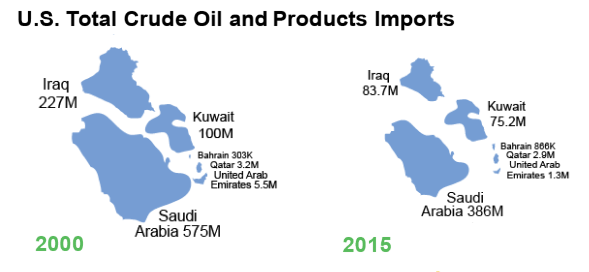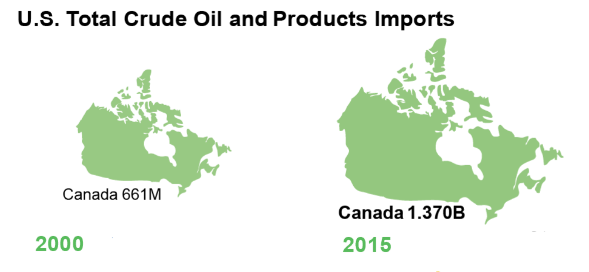This means that oil is the undeniable 800-pound gorilla in the energy mix for now, and that’s why it still accounts for 35% of all energy consumed in the United States. Throughout the last 50 years, America’s heavy dependence on oil has always created unique political and economic pressures, especially when that oil couldn’t be produced domestically. As we witnessed in the 1970s, untimely oil price shocks can rattle an entire economy, and control over oil production ultimately translated into leverage for foreign organizations like OPEC, and countries such as Venezuela, Iran, or Saudi Arabia.
Shifting Sands
Oil independence is something that almost all U.S. politicians can get behind. It means more domestic job growth, and diminishing influence for foreign oil producers. Propelled by technologies such as fracking and horizontal drilling, the U.S. has been edging towards this goal. Since 2008, U.S. crude oil production has grown from five million to near nine million barrels per day. Now, the U.S. is again the world’s biggest producer. However, as today’s animated graphic from HowMuch.net shows us, there is another significant change that has occurred recently, and it has more to do with where the remaining foreign oil comes from. In particular, oil imports are shifting from the sands of Saudi Arabia to the oilsands of Canada. The below image shows how U.S. oil imports coming from Saudi Arabia and the Middle East have dropped drastically over the last 15 years:
Compare that to Canada, which now exports a whopping 1.37 billion barrels of oil to the U.S. each year.
If this trend continues, it could have big implications on foreign policy. Can the United States continue to wean off its dependence on the Middle East? If so, Saudi Arabia’s role as a necessary “friend” in the region may dissipate over time, completely changing the composition of Middle Eastern geopolitics. It also raises interesting questions from environmental and economic perspectives about Canadian oil, which mostly comes from the Athabasca Oilsands. Bitumen is particularly expensive to produce, and the extra heavy oil already sells at a discount in American markets. With oil now hovering close to $40 per barrel, what does the future of Canadian oil look like ten years down the line? Further, will concerns over emissions and pollution stemming from the oilsands have any effect on production capabilities as time goes on?
on
#1: High Reliability
Nuclear power plants run 24/7 and are the most reliable source of sustainable energy. Nuclear electricity generation remains steady around the clock throughout the day, week, and year. Meanwhile, daily solar generation peaks in the afternoon when electricity demand is usually lower, and wind generation depends on wind speeds.As the use of variable solar and wind power increases globally, nuclear offers a stable and reliable backbone for a clean electricity grid.
#2: Clean Electricity
Nuclear reactors use fission to generate electricity without any greenhouse gas (GHG) emissions.Consequently, nuclear power is the cleanest energy source on a lifecycle basis, measured in CO2-equivalent emissions per gigawatt-hour (GWh) of electricity produced by a power plant over its lifetime. The lifecycle emissions from a typical nuclear power plant are 273 times lower than coal and 163 times lower than natural gas. Furthermore, nuclear is relatively less resource-intensive, allowing for lower supply chain emissions than wind and solar plants.
#3: Stable Affordability
Although nuclear plants can be expensive to build, they are cost-competitive in the long run. Most nuclear plants have an initial lifetime of around 40 years, after which they can continue operating with approved lifetime extensions. Nuclear plants with lifetime extensions are the cheapest sources of electricity in the United States, and 88 of the country’s 92 reactors have received approvals for 20-year extensions. Additionally, according to the World Nuclear Association, nuclear plants are relatively less susceptible to fuel price volatility than natural gas plants, allowing for stable costs of electricity generation.
#4: Energy Efficiency
Nuclear’s high energy return on investment (EROI) exemplifies its exceptional efficiency. EROI measures how many units of energy are returned for every unit invested in building and running a power plant, over its lifetime. According to a 2018 study by Weissbach et al., nuclear’s EROI is 75 units, making it the most efficient energy source by some distance, with hydropower ranking second at 35 units.
#5: Sustainable Innovation
New, advanced reactor designs are bypassing many of the difficulties faced by traditional nuclear plants, making nuclear power more accessible.
Small Modular Reactors (SMRs) are much smaller than conventional reactors and are modular—meaning that their components can be transported and assembled in different locations. Microreactors are smaller than SMRs and are designed to provide electricity in remote and small market areas. They can also serve as backup power sources during emergencies.
These reactor designs offer several advantages, including lower initial capital costs, portability, and increased scalability.
A Nuclear-Powered Future
Nuclear power is making a remarkable comeback as countries work to achieve climate goals and ultimately, a state of energy utopia. Besides the 423 reactors in operation worldwide, another 56 reactors are under construction, and at least 69 more are planned for construction. Some nations, like Japan, have also reversed their attitudes toward nuclear power, embracing it as a clean and reliable energy source for the future. CanAlaska is a leading exploration company in the Athabasca Basin, the Earth’s richest uranium depository. Click here to learn more now. In part 3 of the Road to Energy Utopia series, we explore the unique properties of uranium, the fuel that powers nuclear reactors.
































